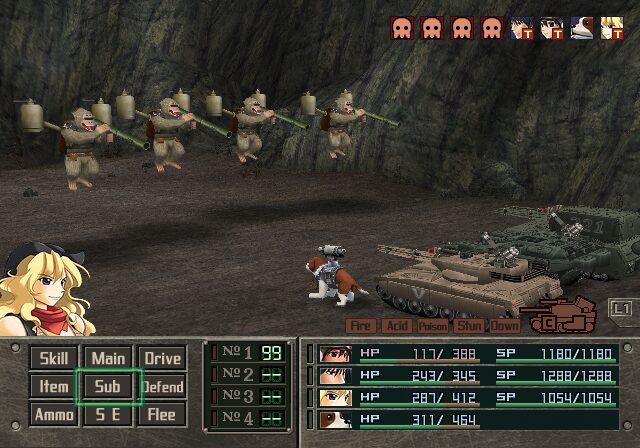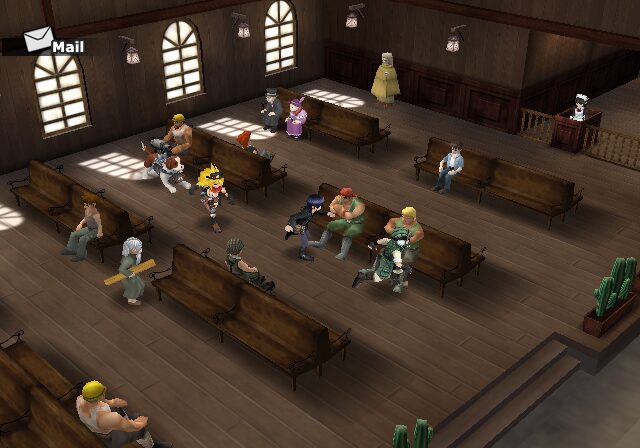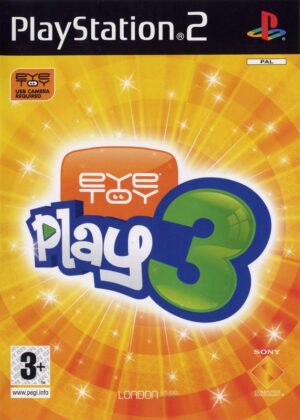Retro Replay Review
Gameplay
Metal Saga offers a breath of fresh air in the Japanese RPG landscape with its open-ended, non-linear approach. From the moment you step out of Junkyard, you’re free to chart your own path across a sun-bleached wasteland filled with outlaws, mutant creatures, and hidden treasures. There is no set sequence of events forcing you down a narrow corridor; instead, missions and story events unfold based on the bounties you choose to accept and the rank you’ve earned as a hunter. This freedom encourages experimentation, whether you’re chasing down notorious bandits or plundering abandoned ruins for valuable tank parts.
(HEY YOU!! We hope you enjoy! We try not to run ads. So basically, this is a very expensive hobby running this site. Please consider joining us for updates, forums, and more. Network w/ us to make some cash or friends while retro gaming, and you can win some free retro games for posting. Okay, carry on 👍)
Combat in Metal Saga is turn-based and spans both on-foot skirmishes and vehicular battles. Your party is limited to four active members, which can include human hunters and a motley crew of armed dogs. Any human character can swap between foot soldier and tank pilot at will, opening up tactical options in every encounter. Tanks offer heavier firepower and greater protection, but foot combat can unleash specialized skills and agility that might turn the tide in tight quarters.
One of the crown jewels of gameplay is the tank customization system. Scattered across the wasteland are dozens of chassis, weapons, and upgrade parts. You’ll salvage engines, treads, cannons, and gadgets to assemble unique vehicles tailored to your play style. Do you prefer a speedy recon buggy bristling with machine guns? Or a lumbering heavy tank that crushes obstacles and survivors alike? The choice is yours, and the visual feedback—down to custom paint jobs saved on your memory card—adds a personal touch that keeps you hunting for more parts.
Progression in Metal Saga doesn’t hinge on leveling through a linear story but on reputation and rank. Completing side quests, defeating high-value targets, and salvaging rare parts all contribute to your status as a top-tier hunter. As you rise through the ranks, new regions open up, tougher foes appear, and special events trigger—sometimes revealing alternate endings. This mechanic rewards players who embrace the sandbox nature of the game and return to earlier areas with better gear to unlock hidden content.
Graphics
Metal Saga’s visual presentation is a charming mix of sprites and pre-rendered backgrounds that capture the desolate beauty of a world reborn from nuclear ashes. Towns like Junkyard feel lived-in, with rusting tanks parked beside wooden shacks and neon signs flickering in the dusk. When you transition to the overworld map, the pixel art landscapes stretch out like a battered tapestry—dusty deserts, irradiated swamps, and crumbling cities awaiting exploration.
Character and enemy sprites are detailed and expressive despite the technical limitations of the era. Hunters sport goggles, bandanas, or combat armor that help differentiate their roles at a glance, while mutant creatures show off imaginative designs—from bone-laden reptiles to hulking mechanical beasts. In combat, attacks are punctuated by impactful animations and screen shakes that make every cannon blast and critical hit feel substantial.
The user interface, particularly the vehicle assembly screen, is elegantly designed. Parts are represented with clear icons and stats, allowing you to compare engines, weapons, and accessories side by side. Even the paint-job feature is intuitive: select colors, patterns, and decals to personalize your ride. While the overall palette leans toward earthy browns and muted grays, occasional bursts of color in towns and character designs help prevent the visuals from feeling monotonous.
Although Metal Saga’s graphics may appear dated to modern eyes, they serve the game’s atmosphere perfectly. The deliberate choice of visuals reinforces the feeling of scarcity and survival, drawing you into a world where every scrap of metal is precious. If you appreciate retro RPG aesthetics and creative sprite work, this game delivers an engaging visual experience that complements its gameplay depth.
Story
Unlike RPGs built around sprawling, cinematic narratives, Metal Saga opts for an understated main storyline that grows organically as you take on bounties. You play as the nameless son of the legendary bounty hunter Eddy, a figure whose exploits shaped the wasteland’s history. Your father’s reputation looms large, but at the outset, your goals are modest: prove yourself, earn money, and carve out your own legacy rather than settling into a mechanic’s quiet life.
The plot skeleton provides context and occasional setpieces, but most of the drama emerges from your choices and the order in which you pursue missions. Hunt down a pirate lord, and you might trigger a rescue event in a distant settlement; become renowned enough, and rival hunters may ambush you on the world map. Some characters join your crew only if you meet them under the right conditions, creating emergent relationships that feel earned rather than scripted.
Because the story branches toward multiple endings based on your rank and completed quests, replay value is high. You might follow a more altruistic path on one playthrough—saving settlements and protecting civilians—and embrace a ruthless bounty hunter role on another. These narrative permutations ensure that no two journeys through Metal Saga feel identical, and every choice carries weight in shaping the wasteland’s fate.
While the dialogue can be sparse at times, the minimalist approach leaves room for player imagination. The world’s backstory, including the rise and fall of superpowers before the apocalypse, is hinted at through item descriptions, NPC chatter, and abandoned archives waiting to be decrypted. Fans of lore hunting will find plenty of threads to piece together, adding depth beyond the core bounty-hunting premise.
Overall Experience
Metal Saga is a niche gem for RPG enthusiasts who crave freedom, customization, and offbeat charm. Its open-ended design encourages you to set your own goals, whether that’s amassing wealth, building the ultimate death machine, or uncovering hidden lore scattered across irradiated wastelands. The mix of on-foot and vehicular combat keeps encounters fresh, and the party system—complete with battle-ready dogs—adds personality to every expedition.
The game’s old-school graphics and sound may not impress those accustomed to blockbuster productions, but they support the rugged, DIY spirit of the setting. Every rusted hull and creaking door feels authentic, and the soundtrack—synth-driven with industrial undertones—complements the desolate atmosphere. If you approach Metal Saga expecting a streamlined story with constant guidance, you may feel adrift; however, players who embrace its sandbox ethos will find one of the most satisfying vehicle RPG experiences ever crafted.
Replayability is a cornerstone of Metal Saga’s appeal. Multiple endings, varied equipment builds, and countless side quests ensure that returning to the game feels like embarking on a fresh crusade. The world is vast but never empty; even lower-level areas can yield surprises when revisited with new gear or a higher rank. This cyclical progression loop keeps the thrill of exploration alive long after the initial hours.
In summary, Metal Saga stands out as a unique RPG that rewards curiosity, strategic thinking, and a love of tinkering. Its post-apocalyptic setting may be familiar, but the freedom to roam, hunt, and build indestructible war machines sets it apart. For buyers seeking an RPG adventure off the beaten path—where your choices truly matter and customization is king—Metal Saga is well worth the ride.
 Retro Replay Retro Replay gaming reviews, news, emulation, geek stuff and more!
Retro Replay Retro Replay gaming reviews, news, emulation, geek stuff and more!









Reviews
There are no reviews yet.